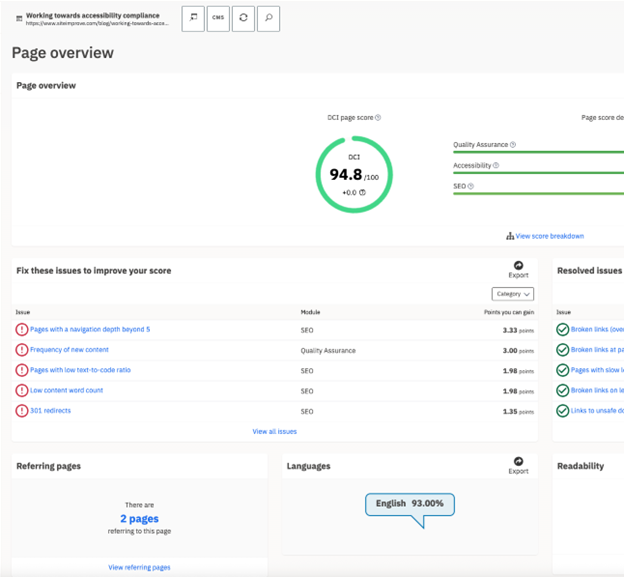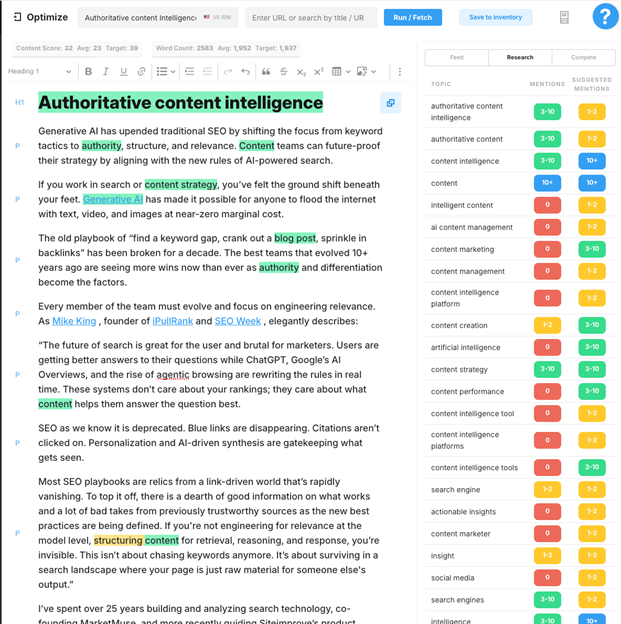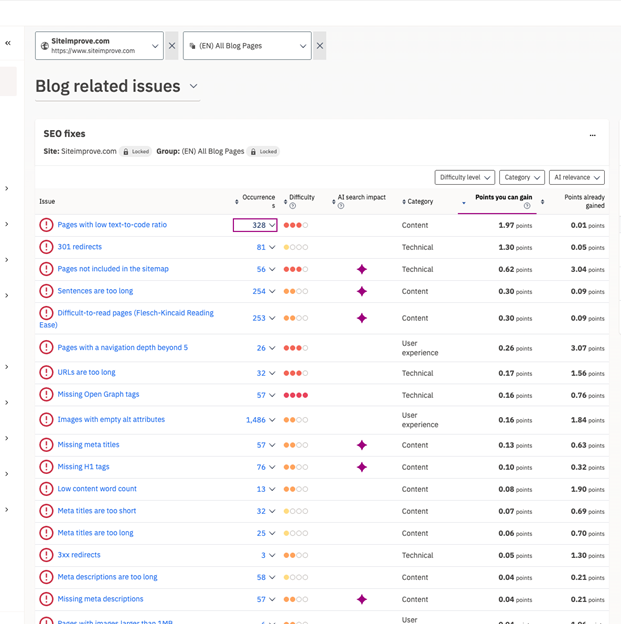Quality content fuels search visibility, brand trust, and measurable ROI. Here’s how forward-thinking content leaders use tools and governance to scale performance—without compromising voice, accessibility, or user focus.
Quality content is the line between a brand people take seriously and one they forget before the page even loads. You can spot a placeholder paragraph or a broken link from a mile away . . . and so can the people you want to impress.
If your copy limps or a page freezes, you’ve given them a reason to move on and remember you for all the wrong reasons. Every awkward sentence and missing alt text chips away at your reputation. Visitors have little reason to trust that a product or service is high quality, when the company’s communication about that produce or service isn’t.
That’s why quality content now powers every part of high-performing marketing teams. It fuels discoverability, it anchors your brand’s voice, and — most importantly — it can be measured, governed, and improved at scale with the right strategy and technology.
Quality content isn’t a checklist you finish once. It’s a moving target, and the smartest teams keep tightening the screws — sometimes in full view, sometimes behind the scenes. Each tweak, each improvement, each time someone cares enough to catch a small miss, your brand gets a little sharper. That’s how reputation is built: not loudly, but steadily, one clear sentence and one working link at a time. For content leaders, this isn’t just about writing better content — it’s about protecting brand reputation and proving that marketing investments deliver measurable business results.
What quality content is and why most teams get it wrong
Ask ten marketers what makes content “high quality,” and you’ll get ten different answers—usually some mix of “it ranks on Google” or “it sounds on-brand.” But the leaders who actually build trust and drive revenue define quality much more precisely:
- Clarity and originality (content that communicates simply and avoids recycled fluff).
- Accessibility and inclusivity (content that works for every reader, on every device, with assistive tech or without).
- Brand consistency (a voice that matches your positioning and doesn’t fracture across teams).
- Performance you can measure (content that moves the metrics that actually matter—pipeline, conversions, retention).
The mistake most teams make? Treating content quality as a gut call or an afterthought. That’s how underperforming blogs, inaccessible assets, and brand inconsistencies sneak into production—and quietly erode ROI.
Siteimprove takes the guesswork out of the equation. Its quality assurance and scoring frameworks benchmark every draft for SEO readiness, accessibility, link hygiene, and brand voice—so you can quantify quality instead of hoping it “feels right.” With dashboards that highlight readability, meta data gaps, and contrast errors, a content team doesn’t need to debate whether something is publishable. They can measure it.

Where Siteimprove ensures you’re meeting non-negotiable standards, MarketMuse pushes content further—surfacing gaps in topical depth, identifying missed subtopics, and showing where a draft lacks authority compared to competitors. Instead of publishing thin articles that risk Google’s indifference, a content team can build content clusters that deliver comprehensive answers and stand up to scrutiny from both search engines and peers.

The payoff? High-quality content earns trust. It tells your audience you respect their time, that you’ve done the research, and that your brand can be relied on for substance—not just noise. Algorithms now reward that trust with higher visibility, but more importantly, decision-makers reward it with attention, engagement, and conversions.
For content leaders, the price of missing the mark is steep: search rankings that slide, inconsistent messaging that confuses the market, and pipeline that never materializes. Benchmarks from Siteimprove and MarketMuse give your team the governance framework to avoid those traps—and the confidence that every asset published is not just “good enough,” but built to perform.
7 proven ways to build high-quality content at scale
For content leaders, these seven methods aren’t just writing tips. They’re frameworks they can use to enable her team to ship high-quality content under pressure, without sacrificing strategic goals.
1. Implement a consistent content structure
Vague briefs lead to vague results. Every project should begin with clear goals, target audience, key points, and how success will be measured.
A reliable workflow isn’t complicated — it’s tight:
- Start with a clear brief.
- Create an outline with key arguments and supporting evidence.
- Draft with voice and structure in mind, not just filling space.
- Edit for clarity and accuracy.
- Run a checklist: metadata, links, accessibility, and brand voice.
Consistency reduces wasted cycles and keeps teams aligned.
2. Match content to search intent and business goals
Ranking content that never converts is a dead end. Use MarketMuse’s competitive analysis to uncover what topics and questions truly matter to your audience — and your pipeline. Align briefs and outlines with both search demand and business intent.
- Top-funnel: Quick to scan, easy to digest.
- Mid-funnel: Deeper analysis, data, or case studies.
- Bottom-funnel: Specific asks, clear next steps.
Educational content works at every stage when it’s mapped precisely to user questions.
3. Write high-quality content for human readers
Formatting is more than aesthetics. It’s usability. Use headings that make scanning effortless, short paragraphs that respect time, and visuals that add value.
Tone should flex by audience:
- B2B: Concise, evidence-driven, connecting directly to business value.
- B2C: More narrative, casual, incorporating reviews and social proof.
Readable content wins with both humans and algorithms.
4. Ensure content accessibility for every user
Accessibility isn’t just a compliance checkbox — it’s an expression of respect. Siteimprove scans for missing alt text, poor color contrast, and broken links directly within your CMS, catching issues before users encounter them.
If someone can’t engage with your site using assistive technology, you’ve not only lost part of your audience — you’ve also signaled to the market that accessibility and inclusion aren’t priorities for your brand..
For deeper perspective, see why website accessibility and design are inseparable.
5. Build topic clusters to improve semantic SEO authority
Keyword density is dead. Google now rewards depth and expertise. Every piece of content should serve two purposes: attract visitors and convert them into customers.
Building topic clusters ensures you cover subjects comprehensively, strengthening authority and increasing both search visibility and user trust.
6. Use feedback loops to continuously improve content quality
Last-minute reviews invite disaster. Build in feedback early. Siteimprove’s real-time checks for broken links, SEO gaps, and accessibility issues mean teams catch mistakes before content goes live.
Continuous improvement systems turn content creation from firefighting into iteration.
7. Iterate and optimize content with performance data
The most effective teams never treat content as “done.” Siteimprove dashboards show which assets fuel conversions, demo requests, or downloads — and which don’t. Iterate on what works, retire what doesn’t.
When you tie every asset to business outcomes, prioritization gets sharper and ROI climbs.
How to evaluate content quality: tools for SEO, accessibility, and broken links
For content leaders, there’s no shortcut to evaluating quality content — smart teams replace opinion with evidence, scorecards, and dashboards. Smart teams swap hunches for scorecards, dashboards, and audit tools that flag what matters before weak spots turn into lost revenue.
Start with the numbers that truly drive the business. Siteimprove’s content performance analytics lets you see where a page stands for SEO, readability, in-brand language, and accessibility—all at a glance. No more switching tabs to check if your CTA color fails contrast or wondering if your meta makes sense out of context.
Scorecards matter as much as the dashboards behind them. Engagement and traffic mean nothing if your structure is muddy, your on-page SEO is a mess, or you’re missing authoritativeness on core topics.
Siteimprove’s dashboards make these gaps visible, so you can sort what needs urgent cleanup from what can wait. If you want to get granular, surface your MarketMuse topic authority stats: see exactly where your page delivers depth, and where you’re just skating by on surface keywords.
Don’t wait for search rankings to crater or complaints to pile up before running a content audit. Use Siteimprove’s audit tools to map out every broken link, missed alt tag, or buried page. Then triage: high-impact fixes first, quick wins next, and save the “nice to haves” for another day.

And when the team says, “Let’s A/B test the landing page design”—expand their thinking. Content versioning isn’t just for color schemes. Test subject lines, intro hooks, CTA language, or even the structure of your how-to sections. Simple swaps can mean big gains in engagement, clicks, and pipeline.
Finally, stop obsessing over keyword density and start tracking actual topical authority. Content that owns its subject moves up—and stays up. Tools like MarketMuse make it obvious when you’re offering real answers and when you’re just stuffing in keywords. Build depth, not just word count, and watch as both performance and brand awareness climb.
When you spot and fix the rot before it gets out of hand, you save time, boost ROI, and—maybe most important—get to focus on creating great content, not just cleaning up after last quarter’s mistakes.
How content quality impacts pipeline, conversions, and ROI
Quality content is only as valuable as the business outcomes it drives. For content leaders, that means every asset must map to pipeline, not vanity metrics like clicks or views. Quality content can—and should—push more than pageviews. When you draw a straight line from each asset to pipeline or lead goals, priorities get clearer and fluff gets cut.
Here’s how the best teams do it:
- Set content goals that map to pipeline. Don’t fill the calendar to look busy. Decide exactly how a blog post, a webinar, or a comparison page will move a reader toward your sales team.
- Track outcomes, not output. Use Siteimprove’s performance dashboards to see which pages fill out demo forms, fuel downloads, or drive direct conversations. If it’s not helping, adjust or retire it.
- Match format and tone to funnel stage. Top-funnel guides should be skimmable, low-jargon, and highly specific about next steps. Mid-funnel content earns trust with data, social proof, or deeper analysis. At the bottom, everything should drive clarity—no rambling, no soft pitches.
- Dial in voice for B2B or B2C. B2B readers want evidence and brevity, but not cold formality. B2C content wins when it’s concise, lively, and direct. Both crave relevance and honesty.
- Make storytelling work for you. Turn wins into case studies. Use interviews, pull quotes, or customer journeys to show how the product fits. The goal is to sound less like a press release and more like you’re talking with a savvy friend, not at an anonymous crowd.
Real-world example:
41 Orange, a property management company, faced poor ranking and limited visibility for competitive local keywords. They built out deep content mapped to specific topical gaps using MarketMuse.
Results? Keywords on page one of Google grew from 10 to 94. Organic traffic jumped 87% in two months. Leads nearly doubled. The campaign is tracking toward $60,000 in new revenue—a 400% ROI. The punchline: They didn’t just spray content everywhere. They used data, mapped every post to a business result, and measured the win.
How to maintain content quality and consistency across channels
Getting your content to the top of the search results is only part of the job. The rest? Making sure it’s worth reading—and worth ranking. Teams that win don’t pick between SEO wins and real user value; they make them work together by design.
Governance is often where content leaders stumble. Without consistent structures, even great teams end up producing content that feels disjointed across web, social, and email. This quick framework helps unify efforts without overburdening teams.
| Challenge | What to Do in Practice | Why it Works |
|---|---|---|
| Content sounds “optimized” but not human | Layer keyword research with a real POV and examples in every section. | Google wants depth, but users want clarity and context. |
| Topic clusters and structure are haphazard | Use MarketMuse or Siteimprove to build and validate semantic topic clusters. | Strengthens authority, increases page relevance, and lines up with how Google now ranks. |
| Pages aren’t earning snippets or rich results | Use clear Q&A, how-to formats, and bulleted lists for key answers. | Boosts chances of landing in featured snippets and voice search. |
| Authority claims fall flat | Show E-E-A-T with author bios, credible links, and real-world proof. | Signals trust to both Google and skeptical readers. |
| SEO content “wins” are hurting readability | Use Siteimprove to balance ranking factors and UX in one workflow. | Keeps copy readable, accessible, and pleasant—for humans and search alike. |
Content quality and SEO aren’t rivals; they’re co-pilots. Teams that keep both front-and-center end up with content that ranks and resonates.
Structuring content for topic clusters and semantic SEO success
Chasing keywords is tiring—and honestly, it’s a losing game. When your site reads like a dumping ground of “optimized” posts, you’re just feeding the machine, not building authority (or trust).
What lifts teams above the churn? They grab a topic and own it, pillar to subpage, every angle covered. They use real data, structure every piece, and keep quality (not word count) as the north star.
Quality matters for reasons most teams miss. Google now rewards depth and expertise, not keyword density or post frequency. While competitors chase outdated metrics, you can focus on why quality content is important — it builds trust that algorithms recognize and decision-makers respond to. Each piece of high quality content works twice: once to attract visitors and once to turn them into customers.
Stop churning out pointless volume. Smart content marketing builds assets that move business goals forward. Build topic clusters that answer real questions your audience asks, not what your editorial calendar happens to have space for.
Content quality isn’t optional anymore. For content temans, it’s the strategic edge that fuels discoverability, trust, and pipeline. With Siteimprove ensuring governance and accessibility surfacing topical depth, your team can scale quality with confidence — not guesswork.
Curious what sharper execution looks like? Request a Siteimprove demo to see exactly where quality is slipping, where you’re strong, and how to stop churning and start climbing.

